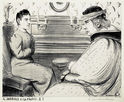
19th, 20th & 21st Century Fine Prints
707-546-7352 · fax 707-546-7924 · web: www.annexgalleries.com · email: artannex@aol.com
Rene Georges Hermann-Paul Biography
Rene Georges Hermann-Paul
French
1864–1940
Biography
Painter, printmaker, and graphic artist Rene Georges Hermann-Paul was born in Paris, France, in 1864. Very little is found on his early life and education, as much of his art went undiscovered until the 1980s. It is known that Hermann-Paul was a prolific artist whose works were exhibited alongside Toulouse Lautrec and Matisse, among others, and he was a celebrated satirical illustrator of French society, in which everyone from the monarchy to the bourgeoise to the lower classes was subject to mockery.
Between the years 1890 and 1914, Hermann-Paul enjoyed a successful, and busy, career as a lithographer and illustrator for a variety of French publications. In addition to this commercial work, however, he was also a fine artist with expert knowledge in woodcut and intaglio printmaking. Among his fine art works are images he created in the "intimiste" style, a la Henri Matisse, Maurice Lobre, Ernest Laurent, and others, who portrayed interiors with families participating in everyday tasks and daily ceremonies - often seen as banal by the more critical of art enthusaiasts, but still popular nonetheless. Hermann-Paul's talent in the genre was such that he warranted an exhibition with his more well-known peers at Henry Graves galleries in 1905.
By the onset of the Great War in 1914, Hermann-Paul was nearing fifty and had established himself as a far-left Dreyfusard, whose social circle consisted of pacifists, radicals, and anti-clericals. Yet the war caught him, as much of Europe, by surprise, and he began to focus on a new body of work to reflect his frustration. Hoping to document his observations of the war, he created a series of woodcuts titled "The Four Seasons of Culture." Instead of finding sympathetic compatriots in this new venture, the work instead set off a maelstrom of division within the left. His friends decried the unflinching and unapologetic depictions of German soldiers looting, raping, and burning their way through Belgium on their way to France; it was seen as violently anti-peace, as though Hermann-Paul trying to stoke the fires of war rather than promote a swift end. By the end of the First World War, Hermann-Paul was alienated.
Hermann-Paul's reputation as an artist never fully recovered in his lifetime, despite his contributions to the printmaking world of the late 19th and early 20th century. He continued to work after relocating to the Saintes-Maries-de-la-Mer region in the south of France. Much of this work was darkly introspective and sometimes focused on the macabre, and though he still worked in his favored mediums - woodcut, lithography, etc., - he took to painting more frequently, although he never mastered the art. He appears to have never exhibited again. Hermann-Paul died in 1944.
His work has since enjoyed renewed interest since collections have come up at major auctions in France. A revision of his work as it reflected the times has allowed Hermann-Paul to once again be considered a major figure a time of intense change within the European art world.

